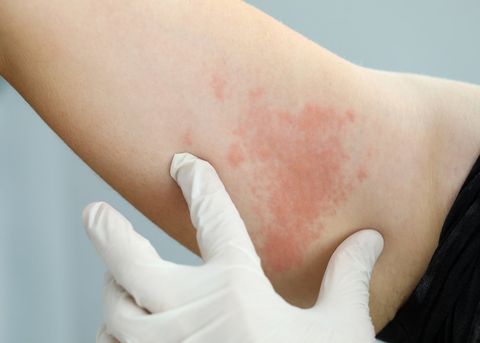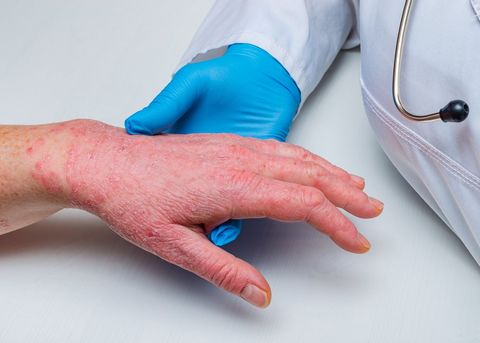Skin Issues
WHAT IS URTICARIA (HIVES) AND WHAT HAPPENS IN THE SKIN?
Urticaria is the medical term for what is commonly called hives. Hives are raised red whelps that are very itchy. The hives cluster in groups on any part of the skin. The size, number and shape vary. Clusters of ordinary hives disappear within 24 hours. As new patches occur, they usually appear on other areas of the skin.
Histamines and other chemical mediators are released from cells into small blood vessels called capillaries. Welts are caused when capillaries dilate. Wheals or welts vary in size. Fluid oozes into surrounding tissue under the skin and causes swelling or raised areas. If you have swelling in the throat (called angioedema), difficulty swallowing, or breathing problems with hives, it is a medical emergency. Histamines and other chemical mediators are released from cells into small blood vessels called capillaries. Welts are caused when capillaries dilate. Wheals or welts vary in size. Fluid oozes into surrounding tissue under the skin and causes swelling or raised areas. If you have swelling in the throat (called angioedema), difficulty swallowing, or breathing problems with hives, it is a medical emergency.
WHAT IS THE DIFFERENCE BETWEEN ACUTE AND CHRONIC URTICARIA?
Acute and chronic urticaria are two categories of hives. Acute urticaria typically lasts from a few hours to a few days; it can last up to six weeks. One is diagnosed with chronic hives when there are, at least, 2-3 episodes of hives per week for more than six weeks. Chronic hives are both transient and recurrent. Chronic hives can last for months or even years and affect quality of life. Idiopathic Urticaria is the most common type of chronic hives.
HOW DOES ANGIOEDEMA DIFFER FROM URTICARIA?
Angioedema (without wheals) occurs deeper below the skin than hives. It can cause sudden and severe swelling of the tongue, face, arms, legs, hands, feet, genitalia, digestive tract or airway. Swelling may cause burning or be painful. Abdominal cramping may result if there is digestive tract swelling. Difficulty breathing or swallowing may occur when the airway is involved. Angioedema and hives may occur in the same patient. There are forms of angioedema that are inherited called Hereditary Angioedema which involve the enzyme C-1 esterase Inhibitor deficiency. This is not an allergy and also can occur spontaneously or due to other diseases. It is now treatable with several new medications.
WHAT TRIGGERS HIVES OR ANGIOEDEMA?
* Medications and foods–the most common!
* Stinging insect venom bites
* Cold-induced(exposure to cold weather)
* Heat-induced
* Exercise-induced
* Dermatographism
* Delayed pressure-induced
* Solar-induced (sun)
* Urticaria with vasculitis
There are allergic and non-allergic causes of urticaria. A patient can have more than one cause of urticaria. When no cause can be found for urticaria, it is called Idiopathic Urticaria.
While many foods potentially cause hives in those allergic to foods, shellfish, fish, nuts, and eggs are common examples. Any medication can lead to hives or angioedema. The most common offenders are antibiotics, aspirin, non-steroidal anti-inflammatory medicines (i.e., Advil or Motrin), and blood pressure medicines such as ACE-inhibitors (i.e., Vasotec and Zestril) or ARBs like losartan. Dyes and additives (i.e., sulfites) in foods or drugs can cause hives. Insect venom from an insect sting, latex products, or even animal dander can trigger hives.
Physical factors or environmental conditions can cause the release of histamine in some individuals results in hives or angioedema. Pressure on the skin, exercise, emotional stress, exposure to heat, cold, sun are examples. Cholinergic urticaria last only 1 to 2 hours. However, delayed pressure-induced hives is typically delayed 2 to 6 hours and lasts longer than other physical triggers, such as vibration, trauma, or excessive use.
Dermatographism means to write on the skin. When the skin is gently stroked or scratched, raised lines appear on the skin from the pressure. Other trauma or physical changes to the skin can trigger the release of chemical mediators like histamine or leukotriene. For example vibration can be a trigger.
Hives may be associated with vasculitis, some infections (even upper respiratory infections or viral infections in children), hormones, alcohol, some cancers, and some autoimmune diseases.
HOW LONG DO WHEALS OR WELTS TYPICALLY LAST?
* Ordinary urticaria (recurrent or episodic) wheals or welts usually last 1 – 24 hours
* Physical urticaria wheals or welts usually last around an hour.
* Delayed pressure hives are delayed 2 to 6 hours and last for about 24 hours.
* Contact urticaria wheals or welts usually last 1 – 2 hours, but sometimes have a delayed phase.
* Urticarial vasculitis wheals or welts usually last 1 – 7 days.
WHAT IS MY MANAGEMENT PLAN?
You may be asked to do one, several or all of these treatments to manage your wheals or welts:
* Eliminate factors that aggravate hives, such as tight clothing, stress, drinking alcohol and overheating.
* Avoid taking NSAIDS, aspirin, ACE-inhibitors, ARBs, codeine (and other opiates) or another regular medication.
* Stop eating certain foods.
* Take an Antihistamine once or twice a day.
* Take a Leukotriene modifier (such as montelukast or Singulair).
* Take an H2 antagonist (such as Zantac (ranitidine) once or twice a day.
* Take a Corticosteroid (such as Prednisone, Dexamethasone or Methylprednisone/Medrol).
* Use an EpiPen or Twinjet Epinephrine shot.
WHAT ARE SELF-HELP TIPS FOR RELIEVING SYMPTOMS OF MILD HIVES OR ANGIOEDEMA?
* Avoidance of known allergens
* Avoid irritating the affected area(s) of the skin
* Take cool showers
* Apply cool compresses
* Minimize vigorous activity; this can irritate the skin
* Wear loose fitting and lightweight clothing
Reminder: Urticaria can be a sign of a more serious illness, such as cancer! Make certain you see your primary care doctor for regular check-ups and follow-up with hickory Allergy and Asthma Clinic as directed. It is your responsibility to follow-up with your care!
ATOPIC DERMATITIS
OVERVIEW
Atopic dermatitis (AD), is also referred to as eczema, a Greek termmeaning to boil over. Eczema is a generic term for inflammatory conditions of the skin, sometimes referred to as weeping rash.
Onset is usually early in life. Six months to one year is typical (may begin at birth) with a high percentage of onset by age five.
Skin is the “target organ” for inflammation secondary to foods and inhalant allergens. AD, an inflammatory condition of the skin, causes intense itching. Breaking the itch and scratch cycle is a major goal of therapy as scratching worsens the condition. Secondary infection of the skin, which can be caused by scratching, must also be treated or prevented.
SUMMARY
Typical findings in
Atopic Dermatitis or
eczema include the following:
- Family history of allergy
- Early age of onset
- Chronic condition
- Dry skin
INTENSE ITCHING USUALLY WORSE AT NIGHT
There is a strong association with allergic rhinitis and asthma.
SYMPTOMS OF ATOPIC DERMATITIS
AD can involve a large portion of the body or manifest as a few localized patches. Patterns of distribution can change with age and seasons can cause variation in the severity, such as worsening during dry winter months.
Early lesions may be red and dry with small inflamed pimple-like spots and mild scaling, with some areas of more significant scaling. Chronically affected skin areas involve thickening of the skin and may have abnormal skin coloring. Lesions are sometimes moist and oozing. Sudden worsening of Atopic Dermatitis may suggest bacterial infection of the skin. Lesions may appear red, crusted, or weepy.
TRIGGERS
Atopic Dermatitis is known to be triggered by foods in a majority of cases, and some evidence supports environmental allergens as a trigger. Irritating substances and overheating of the skin worsen AD.
FOODS
A large number of individuals suffering with Atopic Dermatitis have significant food allergies triggering the inflammatory skin condition. An allergist can take a thorough history and help identify foods that cause AD in a particular individual. Skin testing and a food elimination diet with a plan for reintroducing foods may be recommended.
INHALANT ALLERGENS
Exposure to house-dust mites can worsen Atopic Dermatitis in mite allergic individuals. Measures to limit exposures to house-dust mites are not only important in respiratory allergies such as asthma or allergic rhinitis but also can be part of AD management in some individuals. Pollen directly contacting skin with eczema can worsen skin symptoms in pollen-allergic individuals with AD.
When skin testing is not possible due to eczema, allergy blood tests help identify aeroallergens that are triggering respiratory or AD symptoms.
IRRITANTS
Products containing alcohol, chemicals such as solvents, harsh soaps, overuse of mild soaps, fabrics such as polyester that do not breathe and wool which can be scratchy can cause the skin to get red, itch, and burn. Overheating from exercise, dressing too warmly, or setting thermostats at high temperatures in the winter can contribute to flares of AD. Perspiration irritates AD. Laundry detergents and softeners with fragrance can make the skin worse.
Dry Skin
Atopic Dermatitis can get significantly worse when the skin is dry. Dry skin leads to scratching which worsens eczema. Use all soaps sparingly. Use moisturizers regularly. Petroleum-based moisturizers are recommended. Petroleum jelly (Vaseline®) is best! Do not use lotions with an alcohol base, high water content, or fragrance. Blot the skin with a clean soft, preferably cotton, towel after a bath. Apply medications and Vaseline® immediately after bathing. Keep thermostats low-to-moderate in winter. Winter humidifier use helps if it does not contribute to indoor mold growth.







